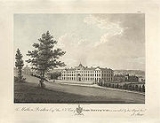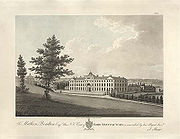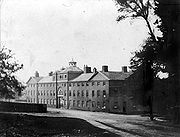
Soho Manufactory
Encyclopedia

Factory
A factory or manufacturing plant is an industrial building where laborers manufacture goods or supervise machines processing one product into another. Most modern factories have large warehouses or warehouse-like facilities that contain heavy equipment used for assembly line production...
which pioneered mass production
Mass production
Mass production is the production of large amounts of standardized products, including and especially on assembly lines...
on the assembly line
Assembly line
An assembly line is a manufacturing process in which parts are added to a product in a sequential manner using optimally planned logistics to create a finished product much faster than with handcrafting-type methods...
principle, in Soho, Smethwick
Smethwick
Smethwick is a town in the Metropolitan Borough of Sandwell, in the West Midlands of England. It is situated on the edge of the city of Birmingham, within the historic boundaries of Staffordshire, Worcestershire and Warwickshire....
, England
England
England is a country that is part of the United Kingdom. It shares land borders with Scotland to the north and Wales to the west; the Irish Sea is to the north west, the Celtic Sea to the south west, with the North Sea to the east and the English Channel to the south separating it from continental...
, during the Industrial Revolution
Industrial Revolution
The Industrial Revolution was a period from the 18th to the 19th century where major changes in agriculture, manufacturing, mining, transportation, and technology had a profound effect on the social, economic and cultural conditions of the times...
.
Beginnings
The factory was established by the "toy" manufacturerToy industry
The toy industry is an economic sector that produces small goods in any material. The production of toys is called toymaking. Hinges, buttons, belt buckles and hooks are all examples of goods that were once considered "toys" and could be produced in metal, leather or glass, amongst others...
Matthew Boulton
Matthew Boulton
Matthew Boulton, FRS was an English manufacturer and business partner of Scottish engineer James Watt. In the final quarter of the 18th century the partnership installed hundreds of Boulton & Watt steam engines, which were a great advance on the state of the art, making possible the...
and his business partner John Fothergill. In 1761, they leased a site on Handsworth
Handsworth, West Midlands
Handsworth is an inner city area of Birmingham in the West Midlands, England. The Local Government Act 1894 divided the ancient Staffordshire parish of Handsworth into two urban districts: Handsworth and Perry Barr. Handsworth was annexed to the county borough of Birmingham in Warwickshire in 1911...
Heath, containing a cottage and a water-driven metal-rolling mill. The mill was replaced by a new factory, designed and built by the Wyatt family of Lichfield
Lichfield
Lichfield is a cathedral city, civil parish and district in Staffordshire, England. One of eight civil parishes with city status in England, Lichfield is situated roughly north of Birmingham...
, and completed in 1766. The cottage was later demolished and Boulton's home (Soho House
Soho House
Soho House , Matthew Boulton's home in Handsworth, Birmingham, England, is now a museum , celebrating his life, his partnership with James Watt and his membership of the Lunar Society of Birmingham. It was designed by Samuel Wyatt and work on the current building began in 1789...
) was built on the site, also by the Wyatts.
Water was drawn from Hockley Brook
Hockley Brook
Hockley Brook is a brook, or stream, in north Birmingham, England. It rises just outsdie the city, in Smethwick, and runs through the city's Soho, Hockley and Aston districts, to its confluence with the River Tame, beneath Gravelly Hill Interchange. From there, its waters flow, via the Trent, to...
.
Production
The Manufactory produced a wide range of goods from buttonButton
In modern clothing and fashion design, a button is a small fastener, most commonly made of plastic, but also frequently of seashell, which secures two pieces of fabric together. In archaeology, a button can be a significant artifact. In the applied arts and in craft, a button can be an example of...
s, buckle
Buckle
The buckle or clasp is a device used for fastening two loose ends, with one end attached to it and the other held by a catch in a secure but adjustable manner. Usually overlooked and taken for granted, the invention of the buckle has been indispensable in securing two ends before the invention of...
s and boxes to japanned ware
Japanning
Japanning describes the European imitation of Asian lacquerwork, originally used on furniture. The word originated in the 17th century.- Japanned :Japanned is most often a heavy black lacquer, almost like enamel paint...
(collectively called "toys"), and later luxury products such as silverware
Silver
Silver is a metallic chemical element with the chemical symbol Ag and atomic number 47. A soft, white, lustrous transition metal, it has the highest electrical conductivity of any element and the highest thermal conductivity of any metal...
and ormolu
Ormolu
Ormolu is an 18th-century English term for applying finely ground, high-karat gold in a mercury amalgam to an object of bronze. The mercury is driven off in a kiln...
(a type of gilded bronze
Bronze
Bronze is a metal alloy consisting primarily of copper, usually with tin as the main additive. It is hard and brittle, and it was particularly significant in antiquity, so much so that the Bronze Age was named after the metal...
). It was also home to the first steam
Steam
Steam is the technical term for water vapor, the gaseous phase of water, which is formed when water boils. In common language it is often used to refer to the visible mist of water droplets formed as this water vapor condenses in the presence of cooler air...
-powered mint
Mint (coin)
A mint is an industrial facility which manufactures coins for currency.The history of mints correlates closely with the history of coins. One difference is that the history of the mint is usually closely tied to the political situation of an era...
, whose presses were subsequently used at the first Birmingham Mint
Birmingham Mint
The Birmingham Mint, a coining mint, originally known as Heaton's Mint or Ralph Heaton & Sons, in Birmingham, England started producing tokens and coins in 1850 as a private enterprise, separate from, but in cooperation with the Royal Mint. Its factory was situated in Icknield Street , on the edge...
In later years, the Manufactory was served by canal at Soho Wharf, at the end of the short Soho Branch of the Birmingham Canal Navigations
Birmingham Canal Navigations
Birmingham Canal Navigations is a network of navigable canals connecting Birmingham, Wolverhampton, and the eastern part of the Black Country...
' Soho Branch Loop Line.
Demolition
The manufactory was demolished in the middle of the 19th century and the site used for housing. In the 1990s the television archaeologyArchaeology
Archaeology, or archeology , is the study of human society, primarily through the recovery and analysis of the material culture and environmental data that they have left behind, which includes artifacts, architecture, biofacts and cultural landscapes...
programme Time Team
Time Team
Time Team is a British television series which has been aired on Channel 4 since 1994. Created by television producer Tim Taylor and presented by actor Tony Robinson, each episode features a team of specialists carrying out an archaeological dig over a period of three days, with Robinson explaining...
excavated the foundations, in some of the local back gardens.


